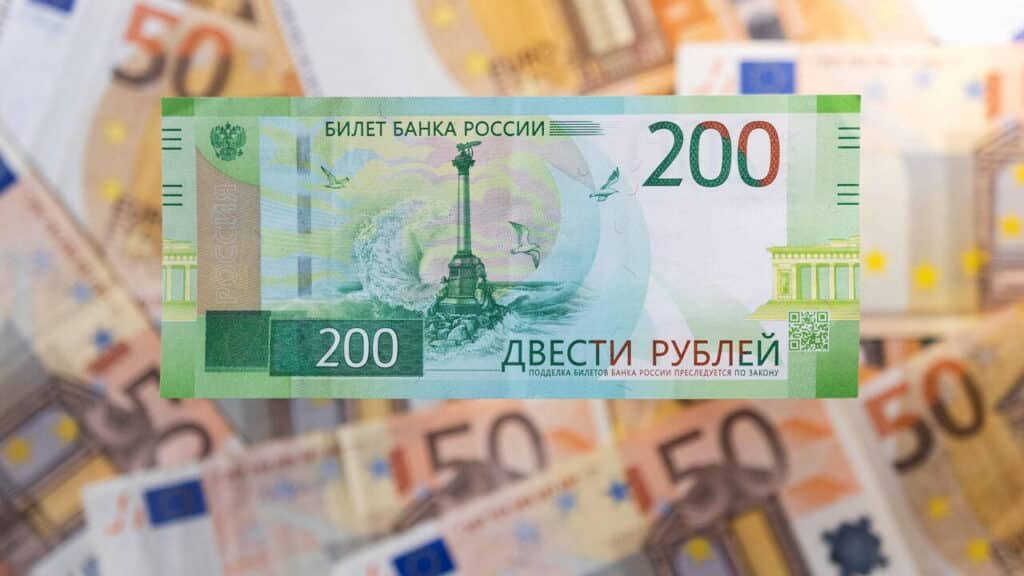Edited by Matt Waller
The Russian rouble is displaying cautious volatility as it inches downward ahead of a highly anticipated series of talks between U.S. and Russian officials. With the upcoming meeting scheduled in Riyadh on February 18, market participants are closely monitoring every tick in the currency’s value, as even modest fluctuations carry significant geopolitical and economic implications.

A Modest Dip Amid Heightened Geopolitical Anticipation
At 09.15 GMT on Monday, the rouble was trading at 91.40 per U.S. dollar—a 0.3% decline from earlier readings. This dip comes on the heels of what has been a remarkable rally for the rouble this year, as it has appreciated nearly 20% against the dollar. Despite today’s slight weakening, the current level remains the highest since September 2024, reflecting robust underlying fundamentals and the market’s optimistic outlook on easing tensions with the West.
Similarly, the rouble fell by 0.3% against the Chinese yuan, the most actively traded currency in Russia on the Moscow Stock Exchange. Such parallel movements underscore the sensitivity of the Russian currency to both domestic and international factors, particularly as investors position themselves ahead of diplomatic engagements.
Key Developments in Diplomatic Engagements
A focal point for the markets this week is the scheduled meeting in Riyadh between U.S. and Russian officials. This session is viewed as a critical preliminary step toward a broader thaw in U.S.-Russia relations—possibly even setting the stage for a direct, high-level meeting between President Donald Trump and Russian President Vladimir Putin.
According to reports, the U.S. delegation in Riyadh is expected to include prominent figures such as Secretary of State Marco Rubio, National Security Advisor Mike Waltz, and White House Middle East Envoy Steve Witkoff. Although details of Russia’s delegation have yet to be disclosed, the very prospect of these talks has buoyed market sentiment, with many speculators anticipating that a breakthrough could lead to a relaxation of sanctions and improved economic ties, particularly in the energy sector.
Market Sentiment and Speculative Capital
The initiation of these high-level negotiations may continue to generate positive news, encouraging speculative capital to buy the rouble. The starting negotiations in Saudi Arabia may continue to fuel a positive news background, which will maintain the buying of the rouble by speculative capital. This sentiment is crucial, as investor confidence has been a key driver behind the rouble’s impressive 20% gain this year—a rally largely attributed to hopes of a reduction in geopolitical tensions.
The Broader Economic Context
The rouble’s performance is not only a barometer of geopolitical sentiment but also reflects broader economic trends within Russia. The currency’s strength this year has been supported by stable commodity prices and a general market consensus that sanctions may be eased if diplomatic progress is achieved. Should the talks in Riyadh yield positive results, further improvements in the rouble could be expected, with potential downstream effects on Russian energy exports and international trade.
Moreover, the slight weakening observed today might be interpreted as a temporary pause amid the anticipation of the upcoming discussions. With the rouble having reached a high watermark recently, any minor corrections could simply be healthy market adjustments before a renewed rally if the diplomatic process unfolds favorably.
Historical Perspective and Future Outlook
Historically, the Russian rouble has been highly sensitive to geopolitical events. Episodes of heightened tension in the past have led to rapid depreciations, while periods of improved relations have bolstered the currency significantly. This historical context reinforces the view that the current market behavior is part of a broader cyclical pattern driven by both political and economic considerations.
Looking ahead, the outcomes of the Riyadh talks will likely serve as a bellwether for the rouble’s medium-term trajectory. A successful negotiation, potentially paving the way for more direct engagement between U.S. and Russian leaders, could unlock further appreciation in the rouble by easing market fears over sanctions and geopolitical risk. Conversely, any setbacks or indications of continuing tensions might trigger renewed selling pressure, leading to greater volatility.
Conclusion: A Balancing Act in a Dynamic Environment
As the week unfolds, the Russian rouble remains at the center of a complex interplay between geopolitical negotiations and economic fundamentals. While today’s modest 0.3% decline may seem insignificant in isolation, it is emblematic of the cautious optimism that pervades the market. Investors are watching the upcoming Russia-US talks in Riyadh with bated breath, understanding that these discussions could be a turning point in the long-running saga of East-West relations.
For market participants and policymakers alike, the key takeaway is that in an environment marked by both opportunity and risk, every percentage point matters. The rouble’s performance, steeped in both domestic resilience and international speculation, offers a compelling case study in how currency markets can reflect—and react to—the unfolding narrative of global diplomacy.
Staying abreast of these developments will be crucial for anyone with exposure to emerging market currencies or interests in the broader geopolitical landscape. As always, the confluence of diplomatic breakthroughs and economic indicators will continue to shape the future of the Russian rouble and its role in global markets.